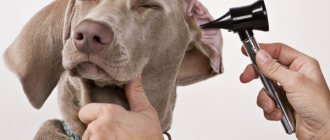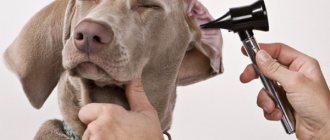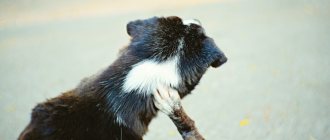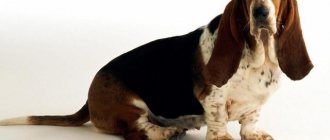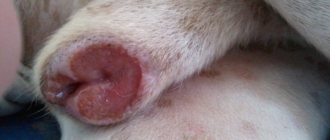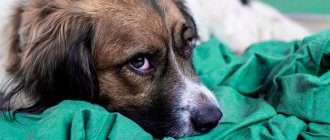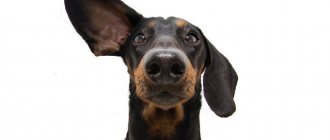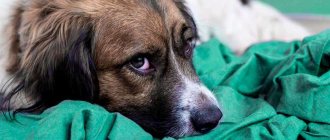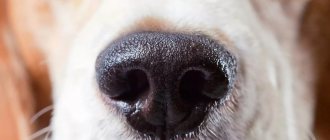Due to the specific structure of the ear, dogs are often susceptible to otitis media. Inflammation of the middle ear in dogs is often diagnosed; internal and external are less common.
The disease causes discomfort and severe pain to the pet. A visit to the veterinarian will help free the dog from uncomfortable sensations and prevent it from developing into a chronic form. An advanced disease can develop into complete deafness and provoke the death of a pet.
Root causes of otitis media
Otitis in a dog occurs for several reasons:
- Ear mites are a common cause of ear inflammation in dogs. Infection is possible from infected animals.
- A tumor becomes a provocateur of otitis media if it clogs the ear canal and interferes with the “ventilation” of the ear.
- Allergies to food, treats, medications and shampoo can lead to ear disease in your dog.
- A foreign object lodged in the ear. Often plant seeds, midges or blades of grass get into the ear, thereby causing otitis media in the dog.
The disease often develops due to insufficient care of the pet’s ears, but it also happens the other way around: excessive cleaning of the ears leads to the destruction of the protective layer, sebum and wax secretions.
The cause may also be weak immunity, bad teeth and hormonal imbalance.
Owner reviews
Anna: “Due to problems, we missed the onset of otitis in our pug. They attributed the hearing loss to old age: the dog is already 10 years old. Moreover, there are no other signs. When I had a free minute, I took my pet to the vet: he said that he had a bacterial inflammation of the outer ear. Prescribed cleaning lotion and Otibiovin. I noticed improvements on the 4th day: I unwrapped the candy and my tail came running to the rustle of the wrapper) They continued dripping for another 5 days, after which the doctor said that we were completely cured. The drops, although expensive, are effective: they helped quickly, the sore never returned.”
Ruslana: “My old dog has developed otitis media, although I take care of him: we walk in shoes, overalls and a hat. After examination, the vet prescribed Otibiovin. The drops quickly helped: after two days the pet felt better. Disadvantages: cannot be stored for a long time, and the bottle is inconvenient.”
Lilya: “My dog started scratching his face, especially hard near his ears. The doctor said that he had mites and prescribed Otibiovin. After the first application, one of the animal’s pupils narrowed, the eye became swollen, and the third eyelid bulged. The veterinarian explained that the drops did not work. Moreover, they made the problems worse. Whether and when the eyes will return to normal is unknown.”
Predisposition of certain breeds to otitis media
Some breeds are more prone to this disease. Most often - dogs with large drooping ears: cocker spaniel, basset hound, dachshund and others. Drooping ears obscure the auditory opening and interfere with “ventilation,” which creates a “paradise” for the reproduction and life of pathogenic microbes.
East European Shepherds also often suffer from this disease. The structure of the ear does not prevent the penetration of dust and microorganisms into it.
Dogs with expressive folds on the muzzle, active swimmers, and those who live in high humidity climates are also at risk.
Answers to frequently asked questions
Can Otibiovin be used in pregnant dogs?
Due to the antibiotic and corticosteroid content of the drug, it is not advisable to use it in puppy dogs. But if necessary, drops are used in pregnant and lactating dogs as prescribed and under the supervision of a veterinarian.
Can the drops be used on puppies?
The instructions do not indicate age restrictions. Medicines are used from the first weeks of life. But if bacteria or fungi are not susceptible to the solution and multiply excessively, the drops are canceled and appropriate therapy is prescribed.
How to store the medicine?
Otibiovin is stored in a dry, dark place at a temperature of +15–25°C, away from children and animals. An unopened bottle does not lose its properties for 2 years; Once opened, use within 12 days, the remainder is thrown away. Therefore, it is better to take a small bottle: you will throw away most of it.
Does the drug help against ear mites?
No, the solution does not contain substances active against ear mites. But it may be prescribed as an additional drug if otodectosis is complicated by a bacterial or fungal infection.
Symptoms
The owner can easily recognize the first symptoms of otitis media in a dog:
- often shakes his head, claws at the sore ear and reacts to touching it;
- upon examination, discharge with an uncharacteristic odor and swelling are noticeable;
- the ear is hot to the touch;
- The dog lies down more and turns away from the food.
If you notice such symptoms, you should consult a doctor.
Possible consequences of the disease
If the dog does not receive proper treatment in a timely manner, or the disease goes too far, the following complications may appear:
- chronic otitis;
- hearing impairment, including persistent ones;
- difficulties with feeding - due to constant pain in the ears, the dog may refuse solid food;
- discharge of purulent contents through the eyes;
- strabismus.
All these consequences threaten serious problems for the pet, so it is the duty of a good owner to quickly contact a veterinarian for help.
Diagnostics
During the examination, the doctor visually assesses the signs of otitis in the dog: the condition of the ears, nasopharynx, mouth and eyes. At the same time, asking questions about feeding, vaccinations and existing pathologies.
Be sure to have scrapings, ear discharge and blood tested. Laboratory tests will show the number of bacteria and parasites and determine their adaptability to medications. They will also determine your general condition and the possibility of allergies.
In some cases, radiography is used. This happens if the research is not informative enough. It shows the presence or absence of tumors and polyps in the nasopharynx. It is also possible to conduct a CT or MRI to exclude the possibility of brain inflammation. Some manipulations can be performed under general anesthesia.
Therapy is prescribed only based on test results. A specialist should tell you how to cure otitis media in a dog. Otherwise, the treatment will not bring results and will worsen the situation.
General rules for application
Otitis media causes many unpleasant and painful sensations. Pets experience discomfort, itching, pain, and their quality of life deteriorates. In such cases, owners want to help their four-legged friends as soon as possible. An erroneous action in such situations is independent and illiterate treatment.
Incorrectly chosen medications and their use often aggravate the situation and otitis media becomes chronic. There are also cases of acute inflammatory processes in the ear.
The outer ear is connected to the animal's brain through the auditory canal. With improper treatment or its absence, serious complications arise that do not go away without leaving a mark on the pet’s health. Therefore, it is extremely important for otitis media to contact a veterinarian for treatment.
Despite the fact that ear drops for the most part have a wide spectrum of action, they are not a universal remedy for all diseases.
Antibacterial drops are not effective for treating viral, fungal or parasitic infections or allergies. On the contrary, they cause complications in such diseases.
Antibacterial drops are not effective against parasites
For infectious diseases, anti-inflammatory and antihistamine drugs alone are not enough for treatment.
The symptoms of otitis media are similar. It is always inflammation, redness, itching. Regardless of the source of inflammation in the ear, therapy should always be comprehensive.
Only a veterinarian can determine the true cause of concern based on a visual examination and laboratory tests.
Only a specialist can prescribe correct and effective treatment for a dog’s disease and choose the right drug for a given disease.
Types of otitis media and their features
Depending on the causes of infection, otitis media transforms into different forms with different symptoms.
Purulent
Purulent otitis in dogs is expressed by discharge from the ears of a yellow-green substance with a sickly-sweet odor. If treatment is not treated in time, weeping ulcers form and the likelihood of damage to the integrity of the eardrum increases, which inevitably leads to deafness.
Chronic
This form of the disease is caused by staphylococcus and streptococcus bacteria. An animal with such a diagnosis needs careful and long-term treatment.
Otomycosis
So, they call fungal otitis media in dogs. Its development occurs for many reasons - reduced immunity, allergic reactions, various infections. Most often, this is a secondary disease that manifests itself as a result of improper treatment of other forms. The ear becomes red and hot, there is increased production of wax and an unpleasant sour odor. In the absence of therapy, the fungus spreads to the entire epithelium.
Bacterial
The development of otitis media in dogs occurs in a similar way to fungal infections. But spread over the entire surface of the skin occurs less frequently. Such otitis may be a complication after a viral infection - plague or enteritis. Accompanied by constant itching and discharge of pus.
Allergic
It is impossible to diagnose allergic otitis in dogs by eye; it can have symptoms of all available forms. The culprits are often food, shampoos, even household chemicals and pollen.
Traumatic
The cause may be a blow to the head, injuries after a fight, scratches and debris in the ear canal. When the wound becomes inflamed, pathological bacteria begin to multiply, which causes ear inflammation in the dog, treatment should begin as early as possible.
Parasitic
Fleas, ticks, lice eaters and other parasites damage the skin, and point inflammation starts.
Seasonal
In slushy weather, an increased content of sulfur is observed in the dog’s ears, which leads to the transformation of sulfur seals and the development of a bacterial infection against this background.
Prevention
Prevention of ONO is carried out in case of frequently recurring episodes of the disease, concomitant dermatological diseases, as well as with regular contact with water - in athletes.
When engaging in water sports or frequently visiting the pool, it is recommended to use swimming caps or special earplugs, and dry your ears after swimming. The outer ear can be gently wiped with a towel. To remove residual water, shake your head vigorously in different directions.
Author:
Chekaldina Elena Vladimirovna otorhinolaryngologist, Ph.D.
Treatment at home
If otitis media is detected in dogs, how to treat it at home? At first, you can alleviate your pet’s condition at home.
As home measures you can use:
- If there is severe scratching, the inner surface of the ear is wiped with hydrogen peroxide and carefully dried with a gauze bandage. Scratches are lubricated with brilliant green.
- If pus has accumulated and the ear “squishes,” you should carefully clean it with boric alcohol, blot it dry and cover it with streptocide powder.
- Dark plaque can be caused by mites. In this case, the auricle is freed from wax accumulations and lubricated with phenothiazine.
Manipulations should be carried out extremely carefully so as not to cause irritation in the affected areas.
Remember that self-treatment of otitis in a dog can lead to serious complications. Therefore, contacting a veterinarian is an important step.
Contraindications and side effects
Otibiovin has almost no contraindications. It should not be used only if the pet is allergic to the active ingredients of the drug and the eardrum is perforated (ruptured). Also make sure that the solution does not get into the dog’s eyes: in this case, rinse them thoroughly.
Side effects are rare. In isolated cases it is possible:
- allergic reactions: itching, rashes, redness;
- temporary deafness in older dogs;
- in case of overdose or use for longer than the permissible period, complications standard for corticosteroids occur: suppression of the adrenal glands, poorly healing wounds, thinning of the skin.
Drops for otitis media
For the complex treatment of fungal otitis, drugs are prescribed that include miconazole, clotrimazole or nystatin.
The following anti-otitis drops for dogs are recommended for use:
- Surolan is an antimicrobial, anti-inflammatory and antiparasitic agent. You can use 3-5 drops twice a day. The course of treatment is 2-3 weeks.
- Aurizon fights bacteria and fungi. Apply 10 drops once a day for 1 week; if the symptoms do not disappear, the treatment is extended for the same period. Contraindicated for bitches expecting puppies.
- Otonazole is an antipruritic, antifungal agent. Use 3-5 drops once a day for 2 weeks.
- If the inflammation is caused by an allergen, antihistamine ear drops for dogs are used for otitis media.
- Sofradex – 2-3 drops, 3-4 times a day. Helps very well with swelling and itching.
- Anauran – 5 drops, 2-4 times a day. Indispensable for swelling and itching.
Treatment for suppurative otitis media in dogs is best done with antibiotic ear drops for dogs.
For example:
- Otibiovet – 4-5 drops. At the beginning of the development of the disease 3-4 times a day, after 3 days 2-3 times.
- Otipax – 4 drops, apply 2-3 times a day for ten days.
- Anandin , the dose here depends on the size of the pet. Dwarf breeds need 3 drops, medium breeds need 4 drops, and large breeds need 5 drops. The medicine is used for 3-4 days twice a day. It is required to repeat the course in a week, unless otherwise prescribed by your doctor.
The parasitic form requires treatment with insectoacaricidal agents.
- Leopard - 3 drops for dwarf dogs, 4 drops for medium-sized dogs and 5 drops for large dogs. Treatment is carried out twice with an interval of a week.
- Amitrazine is used once a day with an interval of 3 days. The procedure must be carried out until the signs disappear.
Otitis resulting from injury is treated with drugs that promote wound healing:
- Otopedin . Since these ear drops for dogs are quite toxic, the ears are treated once a week with 2-3 drops. After manipulation, the ears are fixed open for twenty minutes.
- Aurican needs to be dripped 5 drops for small dogs, 10-15 for medium-sized dogs, and 20 to 30 drops for large dogs. The drug is used daily for a week, then twice a week for another 25-30 days.
To make ear drops for dogs more effective, you need to follow some rules:
- Before the procedure, clean your pet’s ears;
- Warm the drops in the palm of your hand before use;
- when instilling, you need to pull the ear towards the spine, then press and massage a little.
How it works
Otibiovin is a drug with a wide spectrum of antifungal and antibacterial action. The therapeutic effect is achieved through the interaction of 3 active components:
- Gentamicin sulfate. Aminoglycoside antibiotic. Affects some fungi, a number of gram-positive and most gram-negative bacteria: E. coli, Klebsiella, Salmonella, Shigella, Mycoplasma, Enterobakter aerogenes, Pseudomonas aeruginosa, Campylobakter fetus subsp.jejuni, Proteus spp., Actinobacillus spp.
- Salicylic acid. Disinfects the ear linen, soothes, relieves tissue irritation.
- Triamcinolone acetonide. Semi-synthetic corticosteroid. Eliminates inflammation, irritation, swelling and redness.
Treatment with medications
Let's look at several effective schemes for treating otitis media in a dog. The proposed life examples will help you navigate and build the right treatment for your pet.
Option 1
Patient: large dog, weight 40 kg, age 4 years. Owner's complaints: does not allow petting on the head, the dog's ear hurts. Diagnosis: exudative otitis externa.
Local processing:
- Hydrogen peroxide. Using a damp swab, wipe the inside of the ear and the passage. Cleansing from crusts, pus and excess sulfur.
- Chlorhexidine. Wipe the ear treated with peroxide twice a day for half a month.
- Bepanten. Apply the ointment to the inside of the ear 2 times every 24 hours, for a course of two weeks. In severe situations, it is allowed to use Fluorocort or Lorinden.
- Sofradex - inject 3-5 drops into both ears twice a day for 14 days.
Parallel treatment:
- Sinulox or Clamoxil. Inject into the thigh once in the morning, 5-7 days, 4 ml.
- Suprastin. In the withers - inject 1 ml in the morning and evening - a weekly course.
- Serrata. It is necessary to inject 1 pill twice with an interval of 12 hours – 10 days.
Option 2
Patient: male, age – 7 years, weight – 12 kg. Owner's complaints: the dog is restless, his ear is leaking. Diagnosis: purulent otitis media in the chronic stage.
Local processing:
- Peroxide - twice a day, two weeks.
- Chlorhexidine - twice a day treatment for up to two weeks.
- Bepanten - twice a day for two weeks.
- Sofradex – 3-5 drops every 12 hours. The course of treatment is two weeks.
In a difficult situation, the following mixture of drops is acceptable:
Ceftriaxone 1 bottle + Dioxidin 10 ml + 5 ml Novocaine 0.5% + Suprastin 2 ml + Dexomethasone 3 ml + vitamin B12 2 ml + Dimexide 0.5-1 ml. This suspension should be administered 3-5 drops into both ears with a 12-hour interval. The course of treatment lasts 14 days.
At night, you need to apply a gauze swab soaked in the mixture: 2 ml of Lincomycin, 1 ml of Dexamethasone, Suprastin 1 ml and Novocaine 2% 3 ml. Treatment should continue for 10 nights.
Parallel treatment:
- Sinulox – intramuscularly 3 ml once, course of treatment – a week. Let’s say 1 bottle of Cefogram is mixed with Lidocaine 8 mg. Inject 2.5 ml of the prepared drug 1-2 times a day.
- Suprastin - inject 0.5 ml into the outer thigh, morning and evening for 7 days.
- Serrata - twice a capsule - no longer than 10 days.
- Liarsin – 1 pill 2 times a day – 10 days.
- Mezim – take 1 capsule twice a day for 12-14 days.
A blockade with novocaine at the root of the ear may also be useful. For this, novocaine 05% is used, 7 ml twice a day. Treatment duration is 1 week.
Antibiotics for otitis in dogs should be taken with caution, for example, if the eardrum is damaged, drops containing an ototoxic antibiotic are contraindicated.
Release form and composition
Otibiovin is produced by the Czech company Bioveta: an international company operating for more than 100 years. The drops are poured into 15, 20 and 25 ml vials, each of which is equipped with a pipette. More often they sell 20 ml bottles - on average 540 rubles.
Externally, the drug is a clear solution with a pronounced odor of alcohol. It contains 3 active ingredients and 2 auxiliary ingredients: ethanol and water for injection.
| Active components | Content |
| Triamcinolone acetonide | 0.5 mg |
| Salicylic acid | 5 mg |
| Gentamicin sulfate | 2 mg |
Preventive measures
In order not to wonder how to treat otitis in a dog, you should carefully monitor your pet.
For prevention purposes, the following measures should be taken:
- regular examination of the dog's ears;
- cleaning when dirty;
- plucking fur from the ear;
- Never rinse the ears of a healthy animal, this increases humidity in the ear;
- in slush and frost, pets with chronic otitis media should wear a hat;
- visit the veterinary office at least 2 times a year for a preventive examination.
We wish your pet a speedy recovery.
Ear inflammation in a dog: Treatment
Treatment tactics undoubtedly depend on the underlying cause.
In the event of an allergic reaction, it must be controlled: eliminate the allergen and suppress the symptoms.
To suppress secondary microflora, antifungal, antimicrobial drugs or their combinations in the form of drops are used: Surolan, Isotik, Origin, Posatex and others.
To treat parasitic otitis, drops on the withers and cleaning the ears with lotions are most often used, in the absence of a secondary infection.
Clean your ears as they become dirty, no more than once every few days. Sometimes deep lavage under sedation is required.
For otitis media and internal otitis, drops alone are not enough. Long-term systemic antibiotic therapy, for example, Sinulox . At least three weeks.
Sometimes it is necessary to resort to surgical treatment so that meningitis does not develop, but the animal will lose hearing.
For primary secretory otitis, deep lavage under video-otoscopy control is necessary. An incision has to be made on the eardrum, but it recovers quickly. Secretory otitis may recur.
If tumors are present, surgical excision or chemotherapy is performed.
Treatment of otitis media during pregnancy
If you experience ear pain during pregnancy, you should urgently see an ENT doctor. Remember that in this case you cannot apply heating pads or warm compresses to the sore spot! This can be very dangerous if purulent inflammation begins in the ear.
If the pain increases and greatly bothers a pregnant woman, and there is no way to see a doctor in the near future, you can take several independent steps. For example, you should put vasoconstrictor drops into your nose.
Cleaning the ears of dogs and cats
Ear cleaning is carried out only when indicated, either with warm saline solution or special lotions. A veterinarian should also prescribe the use of lotions, as there may be contraindications for their use.
Cotton swabs should not be used at any stage of ear cleaning. Cotton microparticles lead to additional irritation of the skin of the auditory canal and increased secretion; in addition, the pathological contents of the ear canal are only “compacted” deeper into the horizontal, visually inaccessible part of the canal, aggravating the inflammation.
A healthy animal without visible discharge does not need to have its ears cleaned “for prevention.” The norm is a scanty fatty yellowish-gray discharge (“wax”), making the inner surface of the external auditory canal slightly shiny.
Preventative cleaning
may be useful for dogs with stenosis of the auditory canal or poorly ventilated canal (loose-eared, sharpei, etc.), but it should
only be carried out on the recommendation of a doctor
.
If the animal has pathological secretion or an established diagnosis of otitis, it is necessary to pour a small amount of warm (37-38.C) sterile saline solution or a special lotion for cleaning the ears into the ear, keep the animal from immediately shaking its head, lightly massage the ear base, and after a minute allow the dog to shake its head vigorously so that the liquefied ear secretion “flies out” under the influence of centrifugal force. The procedure must be repeated until the solution is clean, after which it is necessary to blot the outside of the ear with a soft, lint-free cloth. You cannot go deeper into the external auditory canal than an adult’s finger can penetrate using cotton swabs and other devices. (c) Veterinary center for the treatment and rehabilitation of animals “Zoostatus”. Varshavskoe highway, 125 building 1. tel. 8 (499) 372-27-37
conclusions
Otibiovin is a good drug.
The antibiotic in its composition copes with almost all bacteria that cause otitis media. And the corticosteroid and salicylic acid relieve inflammation and irritation after the first use. Plus, it is well tolerated by dogs: in my practice, I have not observed allergies or other side effects to this drug. But I prefer to prescribe the Belarusian analogue Otibiovet Neo. It is similar in composition and has a better antibacterial and antifungal effect due to the introduction of carbetopendicinium bromide. Plus it costs twice as much.
It is important to understand that Otibiovin and similar solutions are not used without prior examination. A cytological analysis is needed to determine the type of otitis media and what pathogens it is caused by. If you treat ear inflammation due to otodectosis or allergies, you will only worsen the situation. In the first case, Anandin Plus will be effective, in the second - Otospectrin.
In addition, drops in the ears are only one way to treat otitis media. Additionally, you need to use disinfectant solutions, stimulate the immune system, and in serious cases, use antibiotics or antimycotics.
If your dog has bacterial or fungal otitis, and the veterinarian prescribed Otibiovin, feel free to use these ear drops: they are safe and work well against the disease. But check if you can replace them with Otibiovet Neo: this way you will save.
